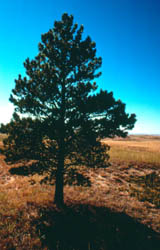State Tree Ponderosa Pine
Updated: August 10, 2020

Pinus ponderosa, Western Yellow Pine, Bull, Black Jack, Western Red, Sierra Brownbark, Heavy, Western Pitch, Ponderosa Pine... Montana's state tree has a long list of names. This stately western Montana resident has figured heavily in the development of all the West.
In what is now South Dakota, Lewis and Clark first observed the cones of the ponderosa pine which had floated that far on the currents of the Missouri River. Captain Lewis, particularly, took extensive notes on the tree as he passed through its habitat later during the journey west and back, but his untimely death in 1809 delayed any serious scientific study of the tree until the end of the 19th century.
Pioneers needed no detailed report to encourage their use of the pine's wood for the civilization they were building. Ponderosa timber served everywhere, from railroad ties and telegraph poles to mine bracing and homes. Only later did its long needles and attractive cones garner more scientific consideration.
In the spring of 1908, Helena's school children held a referendum on which tree best represented the state. The ponderosa easily outdistanced fir, larch, and cottonwood for the designation. It was not until 1949, however, that the Montana Legislature bestowed its blessing. The Montana Federation of Garden Clubs carried on a year-long campaign on behalf of the ponderosa. The state forester supported it as the "most typical" of all Montana trees and the best commercial timber. The "king of the forest," he called it, and the Legislature agreed.
Montana's lumbermen have seconded the praise over the years, harvesting millions of board feet from public and private lands throughout the state. Today the tree may be found in most parts of western Montana. Its range includes the entire West, from the plains to the Pacific Coast. On average the tree reaches maturity when 60 to 125 feet tall (about 150 years old) and approximately 20 to 30 inches in diameter. The largest ponderosa pine on record live along the humid Pacific coast, where California naturalist John Muir once measured a giant, 220 feet tall and eight feet in diameter.
The beauty and value of the ponderosa pine makes it truly representative of Montana and worthy of its designation as the state tree.
Special Acknowledgements to: Montana Historical Society, Rex C. Meyers and Norma B. Ashby
Updated: August 10, 2020

